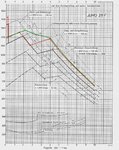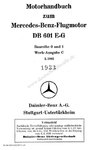When you talk about the price of an engine, or any other piece of equipment for the armed forces, the only valid comparison is the relationship between the cost of that equipment and the money and resources available to build and acquire it for use. If a country is bankrupt, either in cash or resources, it wouldn't matter what the price was. That's the situation Germany found itself in, just a few years after the time frame this thread deals with, isn't it?
Navigation
Install the app
How to install the app on iOS
Follow along with the video below to see how to install our site as a web app on your home screen.
Note: This feature may not be available in some browsers.
More options
You are using an out of date browser. It may not display this or other websites correctly.
You should upgrade or use an alternative browser.
You should upgrade or use an alternative browser.
1941: the best V-12 engine
- Thread starter tomo pauk
- Start date
Ad: This forum contains affiliate links to products on Amazon and eBay. More information in Terms and rules
More options
Who Replied?If you want an indication whether a country could afford a certain equipment, maybe.
If you want to know if engine a or b was easier / cheaper to produce in general it only really makes sense to compare work hours and raw material use. Even that is a bit flawed as naturally a country with e.g. large supplies of high grade alloys will tend design equipment that use those more when compared to a country that has little or no access. Germany is often at a disadvantage in these calculations, having overall few natural resources.
If you want to know if engine a or b was easier / cheaper to produce in general it only really makes sense to compare work hours and raw material use. Even that is a bit flawed as naturally a country with e.g. large supplies of high grade alloys will tend design equipment that use those more when compared to a country that has little or no access. Germany is often at a disadvantage in these calculations, having overall few natural resources.
- Thread starter
- #43
One interesting Jumo engine was the 211J. It was featuring the aftercooler (or intercooler, whatever you like) - quite unusual thing for the single stage engine. It provided power increase, eg. in Steig und Kampflesitung (2400 rpm, 1,25 ata), 1260 PS at 1500m (4840 ft), and 1180 at 4900m (15800 ft). One wonders how good (or bad, like the 601E and 605A were expariencing troubles?) was it performing at 1,40 ata and 2600 rpm?
The red line shows 211J on St Kampf, green line shows 601E on same setting, thick black/gray line depicts 211F. Merlin (not depicted here) still holds the upper hand above 5700m, in raw engine power (more so when we add 1,4% on the HP figure to arrive at PS, that I did not done when drawing the V-1650-1's lines)
A good info about real combat use (and production in 1941, to be sure it fits the thread) is appreciated
The red line shows 211J on St Kampf, green line shows 601E on same setting, thick black/gray line depicts 211F. Merlin (not depicted here) still holds the upper hand above 5700m, in raw engine power (more so when we add 1,4% on the HP figure to arrive at PS, that I did not done when drawing the V-1650-1's lines)
A good info about real combat use (and production in 1941, to be sure it fits the thread) is appreciated
Attachments
Last edited:
- Thread starter
- #45
Thanks for the excerpts. However, the manual is dated February 1942, making it of no influence here (ie. engines of 1941).
The table dated 29th Nov 1941 (here) states that the Start und Notleistung is restricted for the time being (z. Zt. gesp.). Unfortunately, the author of the web page misinterprets that important part, probably since the abbreviation "gesp." is located one line under the abbreviation "z. Zt.".
Excerpt from the table:
The table dated 29th Nov 1941 (here) states that the Start und Notleistung is restricted for the time being (z. Zt. gesp.). Unfortunately, the author of the web page misinterprets that important part, probably since the abbreviation "gesp." is located one line under the abbreviation "z. Zt.".
Excerpt from the table:
Attachments
- Thread starter
- #46
Few sentences from Wikipedia, that mention the Jumo 211J (the version with intercooler):
The [Ju-87]R-4 differed from the R-2 in the Jumo 211J powerplant.[49]
Total production amounted to 972 Ju 87R (105 R-1, 472 R-2, 144 R-4), all built by Weserflug. The last Ju 87R rolled off the production lines in October 1941.[46]
Thanks for the excerpts. However, the manual is dated February 1942, making it of no influence here (ie. engines of 1941).
The table dated 29th Nov 1941 (here) states that the Start und Notleistung is restricted for the time being (z. Zt. gesp.). Unfortunately, the author of the web page misinterprets that important part, probably since the abbreviation "gesp." is located one line under the abbreviation "z. Zt.".
Excerpt from the table:
It is interesting to note in your datasheet that the MG151 engine cannon is of 15mm bore.
- Thread starter
- #48
Not my sheet
Sorry meant to say the sheet you posted. It is dated in Nov 1941. The F-4 was entering service in Jun 1941 but yet it was still fitted with the MG151/15. The other sheet on that website also indicates a MG151/15. In itself not a bad weapon, high velocity and flat trajectory. Imagine a Fw190A with 4 in the wings (for fighter v fighter). Its attributes were probably the reason it was used as the cowling weapon in concert with the MK103 in the Do335.
- Thread starter
- #51
Think the 1942 chart shows the 151/20. The ammo weight is now 80 kg, compared with 73 kg for the chart of 1941, for the same ammo count; the ammo for the MG-151/20 was heavier than for MG-151. In many original publications/documents, one can read just 'MG-151', despite the wepon being of 20mm calibre.
F-4 always had MG 151/20. F-2 had MG 151/15, but the two can be exchanged easily, and some F-2s had the /20 version. It only needs to change the barel and some parts. In both cases maximum rounds was 200, though in practice sometimes less was loaded in field. The 20mm round was based on the 15mm case and were of similar size, but the 20mm version had the round sinked into the generously sized 15mm case.
Users who are viewing this thread
Total: 1 (members: 0, guests: 1)





